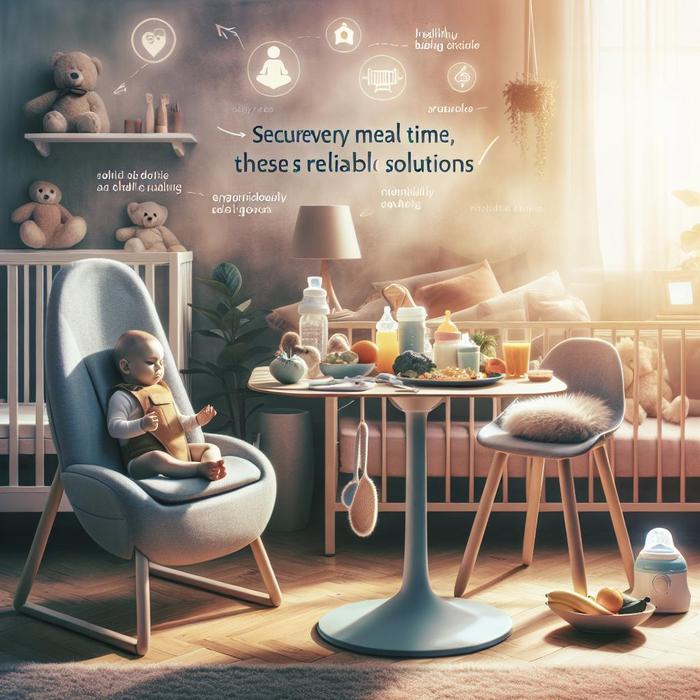Ensuring Safe and Secure Feeding for Your Little-One
Every parent’s primary concern is to ensure their baby’s well-being and safety, especially at meal times. This involves not only the nutritional value of what goes into the bottle but also how we handle and store our baby’s food. A secure feeding environment requires meticulous care, from choosing the right baby gear to maintaining hygienic food storage practices. Let’s explore how to make feeding time a secure, stress-free experience for both you and your baby.
The Importance of Secure Feeding
Secure feeding practices pave the way for healthy growth and development for your baby. It minimizes the risks associated with contamination and unhealthy eating habits, while fostering a sense of security and comfort for your little one. Plus, it gives you peace of mind, knowing that your baby is safe and well-nourished.
Choosing Top Baby Gear for Secure Feeding
Choosing high-quality, biomimetic, and responsible feeding gear helps ensure your baby’s safety and comfort during meal times. Biomimetic feeding gear mimics natural breastfeeding, making bottle-feeding both a healthy and comfortable experience for your baby. Click here to learn more about making responsible bottle choices and how it fosters healthy development for your little one.
Safe Food Handling and Storage
Proper food handling and storage are crucial to secure feeding. Here are some tips to keep in mind:
- Always wash your hands before preparing your baby’s meals.
- Use clean and sterilized feeding bottles and utensils.
- Never reuse leftover milk or juice. Harmful bacteria can grow rapidly in these beverages.
- Store pre-made bottles of milk or formula in the refrigerator to slow down bacterial growth. Look here for more on safe food freezing.
- Always check the temperature of the food before feeding your baby.
- Dispose of any food that smells or looks odd.
You can also check out this resource for comprehensive information on maintaining safe feeding practices for your baby.
Secure feeding also extends to maintaining food safety after emergencies like power outages or natural disasters. The Centers for Disease Control and Prevention offers valuable advice on keeping food safe after an emergency.
Advancements in Biotechnology for Secure Feeding
Advancements in biotechnology are revolutionizing the way we approach baby feeding. The recent executive order by the White House on advancing biotechnology reinforces the importance of innovation for a sustainable, safe, and secure bioeconomy. You can read more about this exciting development here.
Secure feeding practices, top baby gear, and stress-free solutions are within your reach. With sound knowledge and commitment, you can make meal times a joyous and safe experience for your little one.
Promoting Cognitive and Emotional Development
Your baby’s cognitive and emotional development hinges greatly on secure feeding habits. Nurturing food security, according to the World Bank, is not only about having sufficient food, but also about it being safe and nutritious. Regular, secure feeding promotes mental acuity in your baby and gives them the necessary comfort and assurance that their needs are being met. This helps your little one to gradually grow into a secure and confident toddler.
Emphasizing Aging in Place
Safe and secure feeding styles are important beyond infancy. It contributes significantly to promoting “Aging in Place”, a concept authored by National Institutes of Health, emphasizing the importance of creating secure environments from infancy to old age in the comfort of one’s own home. Read more about this idea here.
Safe Food Prep and the Four Steps to Food Safety
Familiarizing yourself with the four steps of food safety: Clean, Separate, Cook and Chill, contributes significantly to secure feeding practices. These steps, backed by sound scientific data, significantly reduce the risk of foodborne illnesses, ensuring that your baby gets only the best nutrition every meal time. Let’s delve deeper into these steps:
- Clean – Wash hands and surfaces often. Use hot, soapy water to thoroughly wash all kitchenware and utensils before and after use.
- Separate – Don’t cross-contaminate. Separate raw meat, poultry, seafood, and eggs from ready-to-eat foods in your shopping cart, refrigerator, and during preparation.
- Cook – Cook to safe temperatures. Use a food thermometer to ensure that food is cooked to a safe internal temperature.
- Chill – Refrigerate promptly. Never leave food out at room temperature for longer than two hours.
The Transition to Solid Foods
Transitioning your baby from milk to solids is a critical phase that requires secure and safe feeding practices. Before introducing any new foods, consult your pediatrician on the right choices and quantities. Stay vigilant to possible allergic reactions. Always follow a phased approach when introducing new foods, giving your baby time to adjust to new tastes and textures.
Supporting Your Baby’s Developing Tastes
Secure feeding involves cultivating healthy eating habits and developing your baby’s tastes. Regularly introduce new foods to prevent your little one from becoming a picky eater. Remember, the food preferences developed during infancy can influence dietary habits for a lifetime.
Safe and secure feeding practices are not as intimidating as they may initially seem. In fact, they are an opportunity for you to bond with your baby, to nurture their growth and to create lasting traditions around food and meal times. Keep in mind that every baby is unique and has their own pace, so don’t be disheartened by comparisons. Keep exploring, learning and enjoying this precious journey of parenting.
Final Thoughts
Feeding your baby is a journey of discovery, nurturing, and above all, love. By ensuring safety, the correct nutritional balance, and mindful practices, you create not only healthy eating habits but also a safe, secure, and nurturing environment for your little one to thrive.

